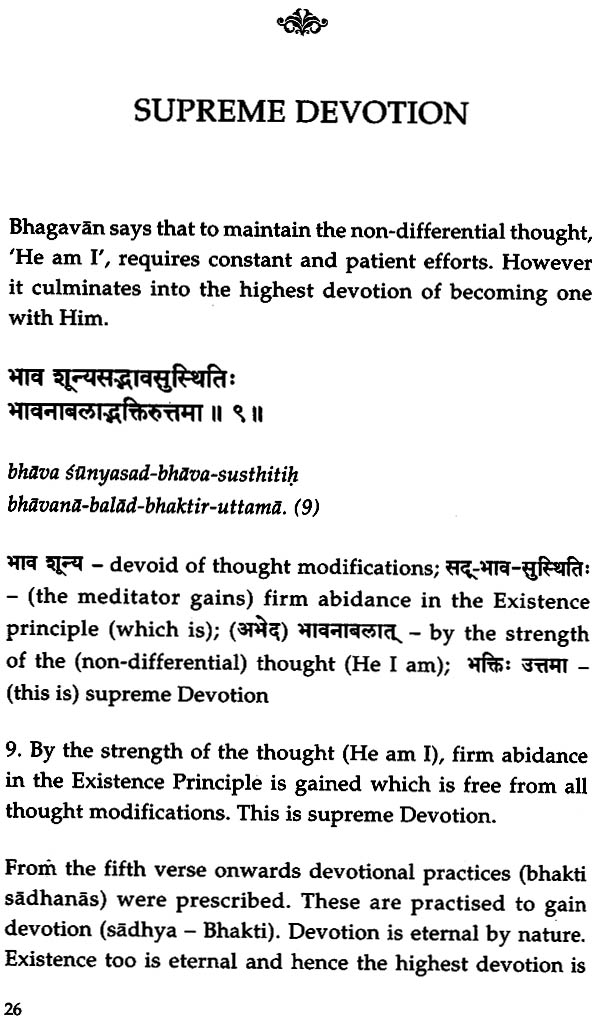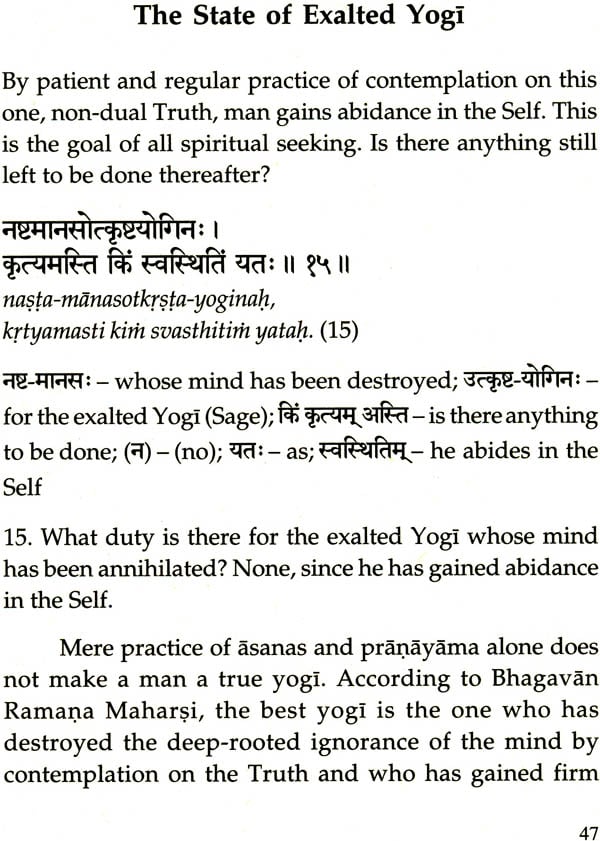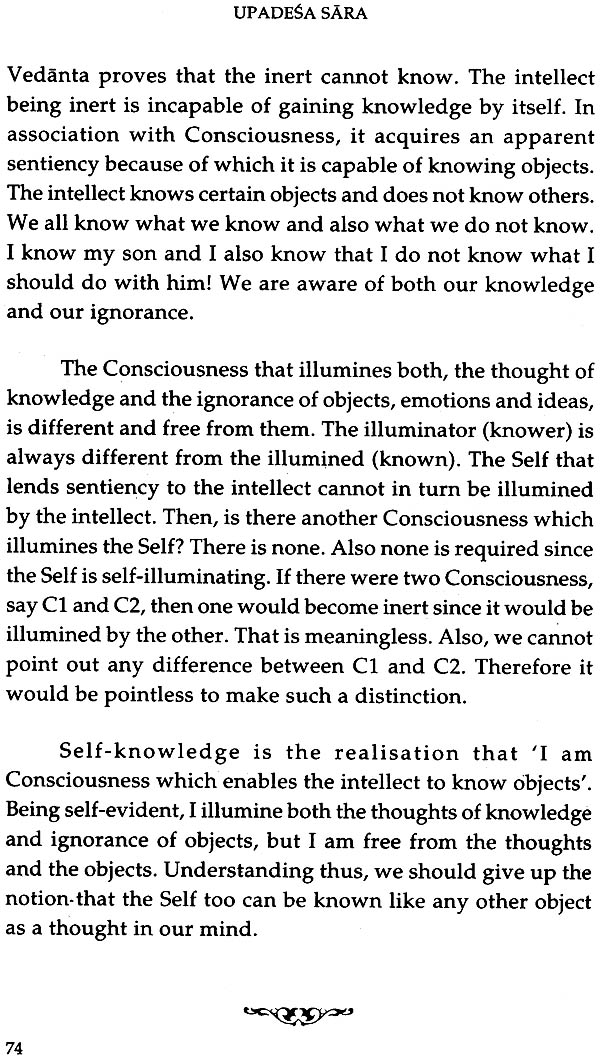
The Essential Teaching (Upadesa Sara)
Book Specification
| Item Code: | IDG390 |
| Author: | Swami Tejomayananda |
| Publisher: | CENTRAL CHINMAYA MISSION TRUST |
| Language: | (Sanskrit Text, Transliteration English Translation & Commentary) |
| Edition: | 2016 |
| ISBN: | 9788175971950 |
| Pages: | 103 |
| Cover: | Paperback |
| Other Details | 8.5 inch X 5.5 inch |
| Weight | 150 gm |
Book Description
The Essence of all teaching is one of the most popular vedantic texts.
It explains the paths of Action (karma Yoga) Devotion (Bhakti Yoga), Yoga (Astanga yoga) and knowledge (Jnana Yoga) and how they lead to the final goal of self knowledge. The great sage Bhagavan Ramana Maharsi presents the subject in a simple and beautiful way.
Pujya Guruji Swami Tejomayananda’s commentary further Simplifies the text and brings out its essence in an appealing way.
The Commentary on Upadesa Sara of Bhagavan Ramana Mahari by Pujya Guruji Swami Tejomayananda, the head of Chinmaya Mission is amongst the most popular Vedantic texts brought out by the Chinmaya Mission. It has been reprinted time and again. There was a need to bring out a better quality edition of this book. CCMT is happy to put before its sincere readers this revised edition.
The re-typing and proof-reading of this latest edition is painstakingly done by Smt. Gayatri Balasubramanian, Coimbatore and Smt. Shobha Maheshwari, Mumbai. The appealing new cover design is created by Shri Krishnamurthi of Mayapuri Graphics, Chennai. May Pujya Gurudev’s blessing be on all.
Vedanta is a deep and serious subject and to explain it in simple terms is rather a difficult task. However, Bhagavan Ramai3a Mahar5i has succeeded in presenting this serious subject in an extremely simple, attractive and beautiful way in Upade4a Sara.
I had occasions to speak on this text in Jnana Yajnas (discourses on Vedanta) organized by the Chinmaya Mission at various places in Madhya Pradesh and Uttara Pradesh. In these Yajnas, it was attempted to present Vedanta in a simple way without getting into intellectual disputations. This text gained popularity at each place and people persuaded me to write a commentary on it. Due to lack of previous writing experience, I was unable to complete the text quickly. The credit in getting me to write goes to Lucknow Mission members and in getting it published, to the Kanpur Mission. The text was initially written in Hindi and later translated into English.
This commentary is specially meant for those who have heard discourses on the text. I sincerely hope that it will benefit others too. This book is dedicated to Pujya Gurudev Swami Chinmayananda.
Bhagavan Ramaiia Maharsi was born on 30th December, 1879 in Tirucuzhi village in Ramnad district of Tamil Nadu. His father Sri Sundaram Iyer was a lawyer by profession. His childhood name was Venkata Ramana. Relations and close acquaintances report that from his early childhood he would go into trance many a times. In reality he was only introspecting. His deep inborn devotion was centered on Aruncala which is worshipped as a Jyotirlinga — the very embodiment of Lord Siva.
Ramana Mahari’s father died when he was very young. Young Ramana did not know then, where Arunachala was located, but he knew well that it was his final destination. In 1895, a relative from Madurai informed him that Arunacala was in Tiruvannamalai in Tamil Nadu.
A year later on 29th August 1896, Venkata Ramana took three rupees from his elder brother’s fees and left home for Tiruvannamalai. Before leaving home he left a note, asking his family not to waste money in his search. The money for the rail fare was insufficient and so he pawned his ear-rings. On reaching Tiruvannamalai, he threw the remaining money into the lake opposite the temple. Having thus renounced all worldly ties, he said words to this effect, “At Your command, I have come to you.” Thus saying, he surrendered totally at the altar of Arunacala. From then on, he never left Tiruvannamalai. He attained Mahanirvana on 14th April 1950, at the age of seventy one.
For the first five months of his stay at Tiruvannamalai, he lived within the temple premises located at the foothills of Arunacala mountain. He would go into long periods of Self-absorption (samadhi). Later, he shifted to the place of bhusamadhi (place of burial place of noble souls) of a Mahatma (noble soul) and still later to a mango orchard. He lived in silence and solitude for years in two different caves of Arunacala and the final years, near the place of bhusamadhi of his mother. Bhagavan’s mother was living with him from 1916 and had died in 1922.
Sri Ramana Maharsi spent his early days at Tiruvannamalai in detachment, silence and self-enquiry. He was known as a man of severe penance, a saint and a divine soul. Some believed him to be an incarnation. His fame spread far and wide and people from all parts of India and other foreign lands came to him and became his ardent devotees.
Sri Ramana Maharsi has composed a few poems in Tamil. They show his literary skill, talent and deep devotion and reflect his vivid insight. His teaching is available in many other books like Ramana Gita, Talks with Ramana Maharsi, Sat Dar4ana, Discussions with Bhagavan and the news letters of Ramansram. He had a good command over many languages and had translated his own Tamil compositions into Sanskrit Malayalam and Telugu.
He was the very embodiment of divine virtues and his life manifested them fully. To this day he inspires lakhs of people irrespective of class color, gender and nationality.
Innumerable creatures live in this God-created world. However, man alone is the roof and crown of creation. Being endowed with an intellect, he comprehends his present state of limitations, bondages, imperfections and incompleteness. He is naturally inclined to free himself from them and attain completeness and perfection and so strives hard to change the present. Transcending the mortal state of the body he desires immortality. He wants complete Knowledge and so wishes to get rid of all ignorance. He is perpetually in search for eternal happiness in which there is not the slightest trace of any sorrow and bondage, be it political, economic, social or religious. In short, he desires and attempts to become a complete and free man. Sad indeed is his plight that despite continuous and untiring efforts from the womb to the tomb, he is still a bound, limited, struggling soul rnable to experience the joy of total freedom. On the other hand, he seems to experience greater bondage as a result of his efforts.
Being within the frame-work of time and space, his actions themselves are limited. Their results can therefore, never be unlimited, infinite and eternal. Hence man cannot attain a state of completeness through actions despite sincere efforts. Then should he give up all efforts to liberate himself? Can he? He cannot. It is because no man can live happily in a state of finitude. Secondly, the desire to liberate himself from sorrows is inherent in him since birth. He does not initiate such a desire on a particular day in his life. The desire being natural, he cannot give it up, and at the same time, actions are unable to fulfill it. The desire for the Infinite could only be fulfilled by gaining the Infinite. But the Infinite cannot be the result of finite actions. Faced with this paradox, what should he do? The answer is found in the Vedas.
It is seen in nature that each thing remains in its inherently natural state. If such a state is somehow lost, it strives continuously till the natural state is regained. Now if man is seen to be always attempting to free himself from the shackles of bondage, it must be because his inherent nature is freedom and completeness. Freedom is freedom from limitations, which is completeness Infinitude. Now the question arises, ‘If man is by nature Infinite, why does he strive towards gaining Infinitude?’ One does not strive to gain the already gained! In case he does, the only reason for this could be ignorance (ignorance of the gained thing). Man strives to be complete and infinite due to ignorance of his true nature and ignorance can only be removed by knowledge (not by actions). Knowledge in turn, can only be gained by a man of pure mind through a valid means of knowledge (pramaita). The valid means for Self-Knowledge is Vedanta or Upanisad.
The Knowledge of one’s own nature is called Self- Knowledge, gaining which man attains liberation and experiences completeness, and without which he cannot rid himself of sorrows even if he strives day and night. Bhagavan Ramana Maharsi was such a man of Knowledge. He composed the Upadesa Sara in Tamil on the request of the Tamil poet, Sri Murugnar. The poet was writing a pauranika (related to the Puräi3a) lore in verse form. The story runs as follows:
Certain ascetics were living in Darukavana (the forest of Daruka). They were devout ritualists and spent their time performing various rituals. They believed in the supremacy of actions in giving results. They were of the view that actions were independent in giving results and that the Lord had no role to play in that. Despite gaining many siddhis (extra-ordinary powers), they experienced a sense of incompleteness and dissatisfaction. Bhagavan Siva, desiring to remove their delusion and sorrow by giving them Self-Knowledge, appeared before them in the guise of an extremely handsome young mendicant, The ascetics continued their rituals ‘undisturbed, but their wives, infatuated by Him, started following Him. Enraged at this, they left their rituals and went in search of their wives. There appeared before them Lord Visnu as Mohini (the enchanting deluding damsel). Charmed by Her, they in turn followed Her. When She disappeared suddenly they realized that the young Mendicant alone was behind this entire mischief. Through their special powers they created various weapons and attacked the young mendicant in order to destroy him. The Lord of Yoga smiled on. Finally it dawned upon them that the mendicant was none other than the lord and took refuge at his feet. Even though the ascetics desired more siddhis the lord explained that the root of sorrow was not the lack of power but the lack of self knowledge. The Lord thereafter imparted this knowledge to them.
| Publisher’s note | i | |
| Commentator’s Note | iii | |
| A Brief Life Sketch of the author Bhagavan Ramana Maharsi | iv | |
| Upadesa Sara | ||
| Introduction | vii | |
| I | Karma Yoga (Path of Action) | 1 |
| 1 | Action in inert | 2 |
| 2 | Barrier to Progress | 6 |
| 3 | Means to Liberation | 9 |
| II | Bhakti Yoga (Path of Devotion) | 13 |
| 4 | Practice of Devotion | 15 |
| 5 | Worship (Puja) | 18 |
| 6 | Repetition of Mantra (japa) | 22 |
| 7 | Contemplation (dhyana) | 25 |
| 8 | Contemplation without Duality | 28 |
| 9 | Supreme Devotion | 31 |
| 10 | The Goal of all paths | 33 |
| III | Astanga Yoga (Path of Yoga) | 35 |
| 11 | Restraint of Prana | 37 |
| 12 | The Source of Power | 40 |
| 13 | Two Stares of Mind | 42 |
| 14 | Means to Reach these states | 45 |
| 15 | State of Exalted Yogi | 47 |
| 16 | Vision of Reality | 49 |
| IV | Jnana Yoga (Path of Knowledge) | 51 |
| 17 | What is Mind? | 53 |
| 18 | I-thought is mind | 56 |
| 19 | Self Enquiry | 59 |
| 20 | Destruction of ego | 61 |
| 21 | The True self | 64 |
| 22 | Who am I? | 67 |
| 23 | Existence consciousness am I | 72 |
| 24 | Relation between Individual and total | 74 |
| 25 | Vision of the lord | 77 |
| 26 | Vision of the self | 79 |
| 27 | Self Knowledge | 81 |
| 28 | Self Realisation | 84 |
| 29 | Bondage and liberation | 87 |
| 30 | Austerity a means to realisation | 91 |









